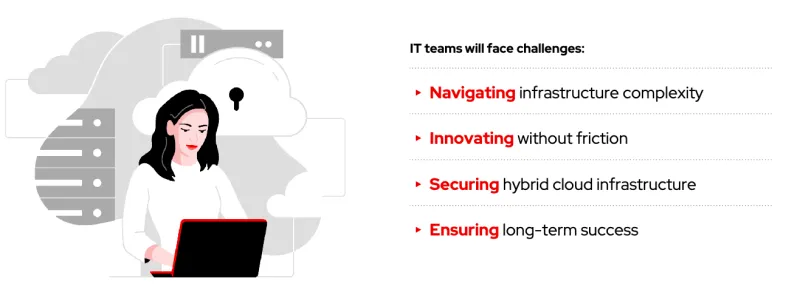Is operating system (OS) standardization still a hot topic in enterprise Linux discussions? The short answer is yes. And I'll tell you why in this blog post.
Due to today's dynamic digital landscape, IT teams face increasing pressure to maintain Linux-based OS systems efficiently while supporting complex workloads like artificial intelligence and machine learning (AI/ML). A recent IDC paper, sponsored by Red Hat, sheds light on the tangible business benefits of standardizing on Red Hat Enterprise Linux (RHEL). The paper, based on interviews with organizations using RHEL, uncovers the real-world advantages of a unified Linux environment. Let’s uncover more of its findings.

Why Standardize on RHEL?
Everybody agrees that managing multiple Linux distributions creates complexity, increases operational costs and strains IT resources. RHEL provides a streamlined, security-focused and scalable platform that helps organizations simplify operations and boost performance. IDC defines “RHEL ‘standardization’ as an initiative undertaken by an organization to deploy more RHEL in its environments that increases the portion of its total deployments running the operating system to 50% or more.”

Key business benefits by the numbers
Based on the IDC paper, enterprise organizations that standardized on RHEL reported significant annual benefits across these key areas:
IT cost savings
- $373K in average annual savings per 100 VMs
- 32% reduction in total cost of ownership (TCO) over 3 years
- 26% reduction in physical servers needed
Operational efficiency
- 34% increase in IT infrastructure team efficiency
- 48% faster on-premises virtual server deployment
- 46% quicker completion of security updates
Performance and risk management
- 54% reduction in unplanned downtime
- 76% improvement in the Mean Time to Repair (MTTR)
- 47% faster response to security vulnerabilities
Business enablement
- $22.1M in additional gross annual revenue
- 48% increase in application development
- 43% faster cloud-based server deployment
How RHEL delivers value
One of RHEL’s key strengths lies in its ability to streamline operations. By standardizing on RHEL, organizations can reduce complexity, cut costs and improve efficiency across their IT environments. Features like automated system management, robust security protocols and uninterrupted integration with hybrid cloud architectures make it a go-to choice for businesses navigating digital transformation.
Moreover, RHEL’s extensive ecosystem of tools and certifications enables compatibility with a wide range of hardware and software, innovation and future preparedness. Whether it’s powering critical systems or enabling agile development, RHEL consistently delivers measurable business value, helping organizations stay competitive in today’s fast-paced digital landscape.
In summary, 4 core values delivered by RHEL include:
- Unified platform
RHEL offers a consistent operating environment across on-premise, cloud and edge infrastructure.
- Advanced automation
Tools like Red Hat Insights and Red Hat Ansible Automation Platform streamline security patching and system updates.
- Enhanced security
Built-in live kernel patching (Kpatch) and robust compliance tools improve overall security posture.
- Scalable support:
RHEL includes 24/7 global support and a predictable 10-year product lifecycle.
Conclusion
For businesses seeking to streamline their Linux infrastructure and optimize their business success, standardizing on RHEL emerges as a powerful strategy.
The IDC study projects a “313% three-year ROI” and a “12-month payback period” for organizations standardizing on RHEL. Beyond financial gains, operational simplicity and enhanced security allow IT teams to focus on innovation and strategic growth. Red Hat has broad offerings across platforms that can help you scale accordingly to your business without any roadblocks.
We offer dozens of labs through an easy-to-use online platform called Interactive Labs, featuring RHEL and other Red Hat technologies. You can explore and experiment with various market trends, such as:
- Create and manage Podman pods
- Secure containers with SELinux
- Use OpenSCAP for Security compliance and vulnerability scanning
- RHEL/SQL Server Install
- Day 2 Operations with image mode for RHEL
For more information, contact your sales channel or business partner.
Try Red Hat Enterprise Linux server today.
製品トライアル
Red Hat Enterprise Linux AI | 製品トライアル
執筆者紹介
My passion for computers and technology started when I was just a kid, and it’s been the driving force behind my career ever since. I’ve always been fascinated by open-source solutions and how they can serve as the foundation for the next generation of enterprise IT. I joined Red Hat Brazil back in 2008, and since then, I’ve worn many hats—Consultant Engineer, Solutions Architect, and Technology Leader, to name a few. My work has taken me across Latin America.
In 2022, I relocated to the USA as a Principal Solution Architect, where I help customers architect and implement cutting-edge solutions powered by Red Hat technologies.
チャンネル別に見る
自動化
テクノロジー、チームおよび環境に関する IT 自動化の最新情報
AI (人工知能)
お客様が AI ワークロードをどこでも自由に実行することを可能にするプラットフォームについてのアップデート
オープン・ハイブリッドクラウド
ハイブリッドクラウドで柔軟に未来を築く方法をご確認ください。
セキュリティ
環境やテクノロジー全体に及ぶリスクを軽減する方法に関する最新情報
エッジコンピューティング
エッジでの運用を単純化するプラットフォームのアップデート
インフラストラクチャ
世界有数のエンタープライズ向け Linux プラットフォームの最新情報
アプリケーション
アプリケーションの最も困難な課題に対する Red Hat ソリューションの詳細
仮想化
オンプレミスまたは複数クラウドでのワークロードに対応するエンタープライズ仮想化の将来についてご覧ください
